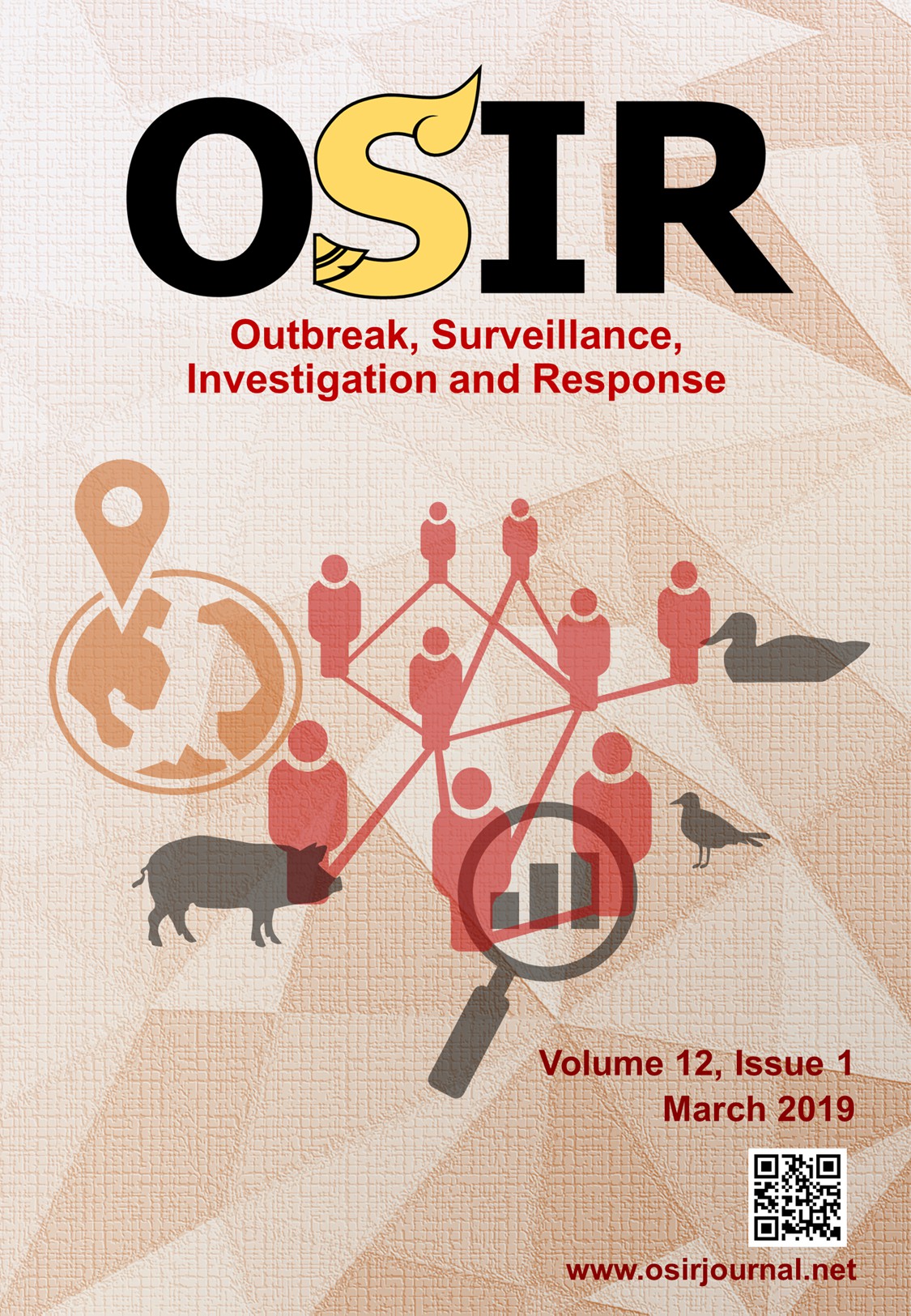Risk Factors Associated with Post-operative Wound Complications in the Animal Birth Control Program, Chiang Mai Municipality, Thailand, 2017
DOI:
https://doi.org/10.59096/osir.v12i1.263016Keywords:
Sterilization, wound, complication, Chiang Mai Municipality, ThailandAbstract
While surgical sterilization is applied in the animal birth control program, Chiang Mai Municipality, with limited resources under field condition, there was concern about complications in post-operative wound healing. This study aimed to describe the incidence of wound complication after surgical sterilization and evaluate the associated risk factors. The investigators conducted a cross-sectional study on the owners and animals participated in the program from March to June 2017. The investigators recorded wound complications and possible risk factors for seven days after the operation, and assessed those factors using risk ratios (RR) with 95% level of confidence. Out of total 141 owners of 252 animals included in this study, 15 (6.0%) animals had post-operative wound complications. Animal receiving cefazolin injection prior to the operation was 0.36 times (95% CI = 0.14–0.97) likely to have wound healing complication than those received penicillin with dihydrostreptomycin. Complete course of either antibiotic or anti-inflammatory drug after the operation could protect animals from wound complications (RR = 0.15; 95% CI = 0.05–0.43). Among female animals, midline incision had lower incidence of complication than flank incision (RR = 0.23, 95% CI = 0.07-0.77). In conclusion, there were 6% of post-operative wound complications in this program. Monitoring of wound complications should be included in every surgical sterilization campaign.
References
Beal MW, Brown DC, Shofer FS. The effects of perioperative hypothermia and the duration of anesthesia on postoperative wound infection rate in clean wounds: a retrospective study. Vet Surg. 2000 Mar-Apr;29(2):123-7.
Brown DC, Conzemius MG, Shofer F, Swann H. Epidemiologic evaluation of postoperative wound infections in dogs and cats. J Am Vet Med Assoc. 1997 May 1;210(9):1302-6.
Coe RJ, Grint NJ, Tivers MS, Hotston Moore A, Holt PE. Comparison of flank and midline approaches to the ovariohysterectomy of cats. Vet Rec. 2006 Sep 2;159(10):309-13.
Food and Agriculture Organization of the United Nations. Dog population management. Report of the FAO/WSPA/IZSAM expert meeting - Banna, Italy, 14-19 March 2011. Animal Production and Health Report. Rome. p. 43-5.
Worldwide Veterinary Service, Thailand. Training Course Manual for the Veterinarians. Bangkok: Worldwide Veterinary Service, Thailand; 2015.
Centers for Disease Control and Prevention. Epi Info [cited 2018 Dec 5]. <http://wwwn.cdc.gov/epiinfo/html/prevVersion.htm>
Heldmann E, Brown DC, Shofer F. The association of propofol usage with postoperative wound infection rate in clean wounds: a retrospective study. Vet Surg. 1999 Jul-Aug;28(4):256-9.
Kustritz MV. Determining the optimal age for gonadectomy of dogs and cats. J Am Vet Med Assoc. 2007 Dec 1;231(11):1665-75.
Muraro L, White RS. Complications of ovariohysterectomy procedures performed in 1880 dogs. Tierarztl Prax Ausg K Kleintiere Heimtiere. 2014;42(5):297-302.
Nicholson M, Beal M, Shofer F, Brown DC. Epidemiologic evaluation of postoperative wound infection in clean-contaminated wounds: A retrospective study of 239 dogs and cats. Vet Surg. 2002 Nov-Dec;31(6):577-81.
World Organisation for Animal Health. ASEAN rabies elimination strategy. Jakarta: ASEAN Secretariat; December 2016. p. 18-21.
Homkong P, Bender JB, Chutipongvivate P, Punyapornwithaya V, Yano T, Kreausukon K. Detection of multi-drug resistant bacterial recovered in a community animal control setting. Asian Journal of Animal and Veterinary Advances. 2017;12:109-114.
Vasseur PB, Levy J, Dowd E, Eliot J. Surgical wound infection rates in dogs and cats. Data from a teaching hospital. Vet Surg. 1988 Mar-Apr;17(2):60-4.
Rutala WA, Weber DJ, the Healthcare Infection Control Practices Advisory Committee. Guideline for disinfection and sterilization in healthcare facilities, 2008. 2017 Feb 15 [cited 2018 Dec 5]. <https://www.cdc.gov/infectioncontrol/pdf/guidelines/disinfection-guidelines.pdf>
Downloads
Published
How to Cite
Issue
Section
License
Copyright (c) 2023 Outbreak, Surveillance, Investigation & Response (OSIR) Journal

This work is licensed under a Creative Commons Attribution-NonCommercial-NoDerivatives 4.0 International License.









